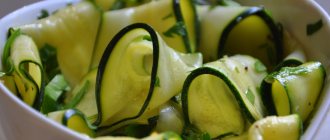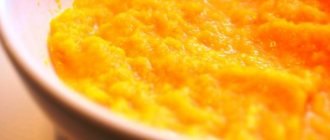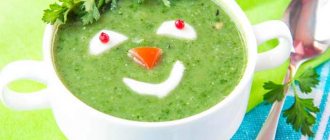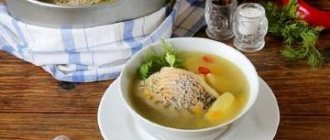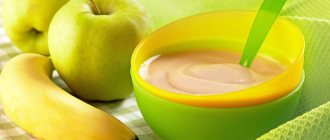The growing body of a baby needs additional nutrition in the form of complementary foods, even if he is breastfed. First of all, vegetables and fruits are introduced into the diet, and then meat. A healthy child of the first year of life begins to be given meat complementary foods at the age of 6–7 months. At this time, it is very important for a child to receive essential amino acids for development, which are found only in products of animal origin. Turkey meat is one of the safest options for complementary meat feeding.
Rules for introducing meat into the diet
A baby over 6 months old can safely be given meat, since its digestive system contains all the enzymes that digest animal products. Often a baby’s introduction to meat dishes begins with turkey, because there is no allergy to it.
In practice, it is better to introduce meat complementary foods to a child 2 months after introducing vegetables and cereals into the diet. If the first complementary feeding was at six months, then meat should be introduced at 8 months. In case of severe anemia, meat puree is given at 6 months.
There are certain rules for complementary feeding:
- It is not advisable to give any new product for the first time during hot weather; this will be an additional burden on the child.
- Complementary feeding should be started when the baby is in a good mood and everything is in good health.
- If your baby is scheduled to have a vaccination in the near future or has already had one, then you should also not change the usual menu.
- There is no need to introduce new products frequently. To get used to the changes, you need to include the next product in the menu no earlier than after 2 weeks.
- For the first time, the baby is given 1 teaspoon of meat puree. It is better to add it to vegetable puree, or dilute it with breast milk, or with formula feeding.
- It is better to do meat feeding at lunchtime, and then observe the child’s reaction. The allergy may appear within a few hours.
The puree is given warm before the main milk feeding. You need to choose a comfortable spoon for your baby - shallow and not wide. It should be convenient for the baby to use such cutlery. He should enjoy the new product, then complementary feeding will go without problems.
The best dish for children
Rabbit and turkey are considered optimal for complementary feeding; allergies to them are very rare. But it is better to consume them in natural rather than canned form. Turkey has many advantages over the meat of other birds and animals:
- it relates to dietary nutrition;
- Turkey fibers are tender because they contain little coarse connective tissue;
- a large number of extractive substances give the dish a pleasant smell and taste;
- Turkey meat contains little cholesterol;
- it can be safely given to a baby who is allergic to chicken egg whites.
Turkey meat has a beneficial effect on the immune system and helps strengthen it. This product is good for the heart, which needs high-quality protein for development and function. Complementary feeding from such a product will be useful and will not cause unpleasant reactions from the digestive system. Especially if the dish is cooked in a slow cooker or steamed.
Turkey for babies - a dietary delicacy
One of the best options would be to choose turkey puree:
- it is easily absorbed by a child’s fragile body;
- it has very little cholesterol;
- contains a lot of high quality protein;
- has a pleasant delicate taste;
- contains easily digestible iron;
- almost never causes allergies.
The product also contains a significant amount of omega-3 fatty acids, which are critical for the development of the baby’s brain and the formation of neural connections in it, helping to strengthen the child’s nervous system. All this further ensures the formation of better cognitive abilities in a grown-up person. The vitamin composition supplies the body with everything it needs and ensures harmonious growth and development.
Turkey meat is not a budget product. But, despite this, taking into account the mass of positive properties, it is worth spending money and choosing it for your beloved child. Its price is due to the high costs of breeding birds. Turkey meat, traditional for America, appeared in our country relatively recently. But it is gradually winning the love of our consumers.
| Energy value per 100 g of product | |||||
| Proteins, g | Fats, g | Carbohydrates, g | Calorie content, kcal | ||
| 19,5 | 22 | 276 | |||
| Vitamin content, mg per 100 g of product | |||||
| A | IN 1 | AT 2 | RR | WITH | |
| 0,01 | 0,05 | 0,22 | 7,8 | ||
| Content of minerals and trace elements, mg per 100 g of product | |||||
| Sodium | Potassium | Calcium | Magnesium | Phosphorus | Iron |
| 90 | 210 | 12 | 19 | 200 | 1,4 |
How to Serve Meat
Puree
The best serving option is turkey meat puree.
Bouillon
This will be a heavy dish for a baby. Turkey soup is recommended for children no earlier than 1.5 years old. The baby's digestive system is not ready to accept such food. Harmful substances from the meat are boiled into the broth. A liquid saturated with active substances increases the secretion of gastric juice and irritates the mucous membrane of the stomach and intestines.
By-products
The tongue and liver are useful for babies, but these products should be introduced into the diet no earlier than 10 months. Liver is a good source of iron and is well absorbed by the body of a small child. But it is the liver that accumulates toxic substances and medications used by animals. That’s why the decision about how much of this by-product a child needs should be decided with the pediatrician.
Canned meat
Many canned products are produced for baby food, including meat dishes. Canned food is convenient to use, its production is controlled, and raw materials are selected to high standards. But it is better not to use them for complementary feeding, because even simple meat puree contains additives, for example, starch. Such extra components should not be present in the baby’s diet, especially at a young age.
Home cooking
It is not at all difficult to prepare soup, meatballs or puree from turkey meat at home. With turkey, you can diversify your child’s menu by preparing hearty and healthy dishes. They can be made steamed, on the stove or in a slow cooker. Over time, your baby will develop a favorite turkey recipe.
To prepare such a dish at home, you need to buy fresh meat and rinse it thoroughly. It is better to take the turkey whole, rather than sliced. The surface color of the piece should be uniform pink. Red color indicates improper storage of the product. You can find a recipe that advises soaking meat of any origin in cold water. This is done to ensure that all harmful substances are released into the water.
From a whole piece you need to cut a piece the size of your palm. For the first time this will be enough. How much the child will eat will be seen in the future. The remaining meat should be cut into the same pieces or a little larger, then put in the freezer. For a small child, all products can be defrosted no more than once. How much meat to cut will become clear later from practice; for soup you need one amount; to cook meatballs, you need a different amount.
Making the broth
You must first cut off the membranes from the turkey, remove cartilage and fat deposits. Place the piece in a pan of cold water, bring the broth to a boil, and cook for about 5 minutes. Then drain the water and add new water. Baby soup should be cooked in secondary broth, this will help get rid of fat and other substances that complicate digestion. For the first complementary foods, this is very important, since meat foods are hard on the stomach.
The water should completely cover the turkey. The baby should be cooked without adding salt or other seasonings, over low heat. You need to cook for about 1.5 hours. When the water boils away, add it. The finished broth must be strained. You can add it to vegetable dishes, cook liver in it, or prepare soup for older children. For children of the first year of life, meat broth is not used.
Soup
Ingredients
Turkey soup for children can be with whole pieces of meat and meatballs - whatever you like.
- Water - 2 liters
- Turkey fillet - 300 gr.
- Onion - 1 pc.
- Carrots - 1 pc.
- Broccoli - 500 grams.
- Rice - 3 tablespoons.
- Greens - 30-40 grams.
- Bay leaf - 1 pc.
- Black and allspice pepper to taste
- Thyme - 1 tsp.
- Salt - 1 dl. ( taste_
- Vegetable oil - 2 tbsp. l.
Preparation
Place a pan of water on the stove.
Cut the turkey fillet into small pieces. When the water has reached a boil, immerse the meat in it and cook for 30 minutes. We clean the vegetables. Cut the carrots into small cubes and the onion into smaller pieces. Wash the broccoli, cut it into florets, and then into small pieces. Pour oil into a frying pan and fry the onion. When it is slightly browned, add the carrots and fry for 5 minutes. Salt to taste. We rinse the rice until the water from under it is clear. Add three tablespoons of cereal to the meat, add carrots and onions. Stir and cover with a lid. Cook for 15 minutes over medium heat. Add broccoli and spices. Reduce the heat to low and cook the soup for about 5 minutes. Before serving, check the readiness of the cabbage: you don’t need to cook it for a long time, otherwise all the benefits will be lost, but you shouldn’t serve it raw either. The last chord will be chopped greens.
Cooking in a slow cooker
Turkey cooks great in a slow cooker. It doesn't take much time or effort. The fillet should be placed on a wire rack and set to “steam”; every multicooker has it. It takes about 40 minutes to cook. Cut the finished turkey into pieces, then grind in a blender until smooth.
Turkey needs to be diluted with something, because its meat is a bit dry. Vegetable oil, vegetable decoction, or just clean boiled water are good for this. The finished dish should not be stored in the refrigerator for more than a day.
How to make delicious turkey puree
Any mother has a good recipe for preparing such a dish; this is the best option for complementary feeding. Cool the boiled turkey and grind it through a meat grinder twice. But for complementary feeding, you also need to grind the turkey in a blender. Even if the recipe does not provide for such a consistency, it is better to give your baby well-chopped meat.
Then dilute the puree with vegetable broth; small children should not add broth. Bring to a boil again, stir well. You can add a piece of butter for taste if it can already be introduced into the diet. If breastfeeding, you can dilute with breast milk. Add as much as needed for the desired consistency, but then do not boil.
How to cook turkey for babies
In this case, you can experiment endlessly. But, when thinking about how to cook turkey for a baby, you need to remember that pureed complementary foods are the best choice. Although kids enjoy consuming broth too. It's quite simple to prepare. You should first prepare the meat: remove films, skin, cartilage. Place a small piece in a saucepan and cover with cold water. Bring to a boil and simmer for about five minutes. It is important that all fats and unnecessary substances come out. After washing the meat, pour cold filtered water and cook until completely cooked. For better absorption, you need to cook the broth for at least an hour and a half. This broth is perfect for a bottle. It will remind your baby of water, but the benefits will be undeniable.
Turkey by-products may be good, but a child should consume them no earlier than one and a half years old. Until then, you should limit yourself to purees, broths and soups.
How to cook turkey for babies
It must be remembered that well-washed and cooked meat contains more benefits and less harm. Therefore, if you want to know how to cook turkey for a baby, you should follow the warning rules. To ensure that no harmful substances, which are unlikely to be contained in this meat, enter the child’s body, it is worth preparing the meat well. Initially, it is recommended to use exclusively sirloin. Rinse the meat well, remove all excess, pour cold water and boil. Drain, rinse again and fill with water. Bring to a boil and cook for at least 7 minutes. Drain and rinse again. Pour in water until the surface of the meat is completely covered, bring to a boil and cook over very low heat for at least one and a half hours. After thorough washing and boiling, the jar will contain only useful substances.
How long to cook turkey for a baby
This issue is resolved individually in each specific case. How long to cook turkey for a baby depends on the meat. Poultry sold in stores is often cooked for no more than one hour. And for domestic animals, even an hour and a half will not be enough, since the fibers are denser, due to proper and natural food, as well as the possibility of free movement. The best option, in both cases, is to cook for an hour and a half. Such meat is easy to puree.
Delicious liver for kids
This offal should be offered to children under one year of age once a week. For such small ones, the liver only needs to be boiled or cooked in a slow cooker. To prepare a tender pate you will need not only liver, but also turkey (a small piece, the same size as the liver). This dish should be given as complementary food if meat dishes are well digested.
The classic recipe calls for equal amounts of offal and meat, but sometimes kids don’t really like the taste of liver. Then its quantity can be reduced; you need to decide for yourself how much to put in.
The liver and turkey should be boiled separately, you can add carrots. Then pass through a meat grinder 2 times or grind with a blender. Sometimes you can find a recipe where there is advice to add butter, but this is for children over one year old. If the pate turns out thick or dry, then it is better to add vegetable broth. Meat broth does not need to be added to pate for small children.
Semi-finished meat products
Cutlets
The classic dish is stewed with a little water rather than fried. Cooking turkey cutlets for children in this way preserves the beneficial properties of the products.
Ingredients:
- meat - 300 g;
- milk - 50 ml;
- white bread - 70 g;
- chicken egg - 1 pc.;
- onions - ¼ pcs.;
- oil - 2 tsp;
- salt - to taste.
Cooking method:
- Soak pieces of crustless bread in milk for 10 minutes.
- Grind the onion and washed turkey in a meat grinder.
- Add egg and salt to the minced meat. Mix everything and form cutlets.
- Heat the oil in a frying pan and lay out the preparations. Add a few tablespoons of water and simmer covered for 25 minutes.
Sausages
The product can be made in advance and stored in the freezer. Cooking sausages is quick and easy.
You will need:
- minced turkey - 400 g;
- milk - 100 ml;
- salt and spices - to taste.
Step-by-step technology:
- Add raw egg, milk, seasonings to freshly ground meat. Mix everything.
- Take a baking bag (cling film cannot be used), thread, scissors. Place 3 teaspoons of minced meat on the corner of the bag and wrap it in a sausage.
- Tie the edge, then release excess air from the workpiece by pulling the other end. Then pull the thread on the other side.
- Cook the sausages for 10 minutes. Remove the casing before use.
Meatballs
If you are going to feed turkey meatballs to a child under one year old, do not add salt or spices to them.
Products:
- rice - 2 tbsp. l.;
- turkey fillet (fresh only) - 250 g;
- onion - 1 pc.
How to cook:
- Grind the meat in a meat grinder.
- Rinse the rice and keep in water for 15 minutes, then combine with the minced meat. Stir chopped onion into the mixture.
- Form into small balls.
- Cook for 20 minutes in a double boiler.
Frozen meat is not suitable for making meatballs; they can only be made from fresh meat.
Meatballs for kids
This dish is not introduced into the first feeding, but much later, when you can eat soup. This happens around the tenth month of the first year. Turkey is great for making meatballs. The simplest recipe is turkey soup.
The fillet, rolled through a meat grinder, is formed into balls and immersed in the soup for 15 minutes. If your baby already has teeth, you can let him try to bite a piece of meatball. When there is still nothing to chew, you will have to mash the meatballs with a fork. You can prepare this dish in a slow cooker. You need to decide how many minutes to set on the timer yourself, it all depends on how big the meatballs will be.
They can also be mixed with buckwheat. This cereal is quite popular in the nutrition of children. And you’ll like it even more with turkey. The finished ground buckwheat and meatballs are mixed, a little butter is added, and the delicious dish is ready.
Turkey allergy
Intolerance to such meat in infants is very rare. The allergy manifests itself as a small rash on the chin or tummy. Usually this does not cause any inconvenience to babies; they do not comb these areas. Rashes may not appear immediately, but six to seven hours after eating, which is why it is difficult to understand the reason for such a reaction. Sometimes allergies manifest as persistent nasal congestion. If the treatment for a runny nose does not produce results, you should consult with an allergist.
In most cases, turkey meat allergies go away with age. To alleviate the baby’s condition, it is necessary to exclude this product from the diet.
More often, allergies occur to canned turkey dishes, but properly cooked meat at home is digested well.
Reasons for poor tolerance
A true allergy to turkey meat is extremely rare - most babies tolerate this type of complementary feeding well, and in some cases, turkey puree can be recommended as a replacement for chicken meat, an allergy to which is several times more common. To reduce the risk of allergies to a minimum, for baby food it is necessary to buy farmed poultry raised on a private farm on natural feed. The meat of domestic turkeys is not processed in any way, does not contain preservative additives that extend the shelf life of the product and antibiotics, which are often injected along with hormonal drugs for accelerated growth.
Among other reasons that can provoke an allergic reaction to turkey meat, experts identify:
- hereditary predisposition (on the part of not only the parents, but also the child’s closest blood relatives);
- pathologies of the immune system (autoimmune disorders, immunodeficiency syndrome);
- poor heat treatment or improper storage of meat (lead to the formation of carcinogens that can cause allergies);
- various forms of fermentopathy - a lack of certain enzymes necessary for the digestion of albumin and gammaglobulin (animal whey proteins).
When introducing complementary foods, it is very important to follow the recommendations on the timing and scheme of introducing new foods. You should not give your child meat products before he is 6 months old. For breastfed children, the introduction of meat into the diet may be indicated by the age of seven months.
Note! An allergy to “canned” meat can be triggered by starch and other components that unscrupulous manufacturers add to the product to increase volume. To accurately determine that the cause of poor health is turkey meat, and not auxiliary components, you need to try several brands of turkey.

